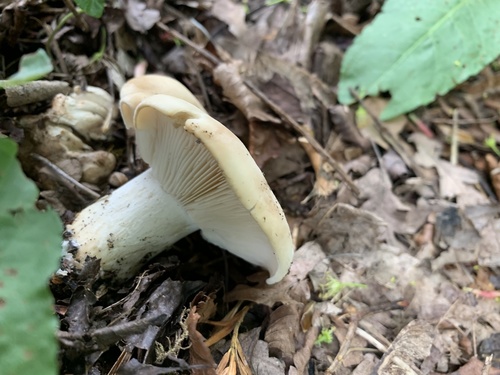
The hungry gap is a time when seeds that you’ve sown aren’t ready and whatever you stored in the winter isn’t good to eat anymore. In this blog post, we’ll look at what the hungry gap is in more detail. We’ll explore the gap’s origins, why we should embrace it and how we can work with it and around it.
So remind me, what is the hungry gap?
The hungry gap is a period of time in the year where sown seeds aren’t ready to be harvested and fruit and veg, that has been stored since the last winter harvest, is no longer good to eat.
Crops can’t be grown without heat and light, so nothing can be planted in the dark, cold months of December and January. We have to wait around 8 weeks – until March and April to start sowing again. Once the seeds are sown, we have to wait another few more weeks to harvest and eat – the waiting time depends on the crop.
There are a few exceptions to the rule though! Which we’ll explore later in this blog.
Origins
You might find this lack of abundance to be an odd thing this time of year, since so much is coming into bloom. But we experience a hungry gap in the UK because of how far up north on the globe we are.
“Most people have never heard of the hungry gap.”
The really odd thing is that most people have never heard of the hungry gap. Odd because it’s something that affects us all around the same kind of time every year. (Though the timing is shifting due to the climate crisis – but that’s a whole other rabbit hole that we won’t go down right now!).
So why have most not heard of the hungry gap? Well, supermarkets do a great job at presenting us with an artificial abundance and variety of fruit and vegetables – artificial because this truly doesn’t exist locally.
Interestingly, some say Shrove Tuesday comes from the gap. After surviving a harsh winter and with little to none of the stored fruit and veg left over, we could take the last of the flour and some eggs and have a feast on pancakes! Then we’d have little to eat during the following period.
This fits with the practices of Lent, where these timely traditions were born out of necessity. There are also interesting synchronicities with fasting during Ramadan! Whatever your religious perspective, it can for sure be acknowledged as an interesting theory!
Why should we embrace the hungry gap?
So we can see that there’s a real clash between what supermarkets want us to do (e.g. eat tomatoes all year round) and what’s ethical and realistically sustainable in the real world.
“There’s a clash between what supermarkets want us to do and what’s sustainable in the real world.”
You might even argue that supermarkets have taken our culture from us – a culture where summertime is celebrated with strawberries and winter is made cosy by potatoes and cabbage.
Instead, the majority of us buy the same dozen types of fruits and veg year round. And this monotonous diet isn’t great for our guts. You can actually get more variety in your diet if you eat seasonally and locally!
These fruits and veg tend to come from annual crops – those that have to be sown and resown every year.
On the other hand, perennial crops are those that grow year on year, harvest after harvest. Unlike annual crops, their seeds don’t need to be resown.
Did you know that perennials tend to have higher levels of micronutrients? Their roots go deeper into the soil, where more micronutrients exist. All the more reason to eat more perennials!
Evading hunger during the gap
As we know, most seeds can be sown around March and April. And then, depending on the crop, we have to wait for the crop to grow and be ready for harvest. For most crops, we have a long wait until harvest – around May and June!
So if you don’t want to go hungry in the months between sowing and harvesting, but you’re still determined to find fresh, local produce, we have to look at our options.
There are some special fellows that are ready to eat before the bloom of abundance in May and June. These are the delicious perennials of asparagus and rhubarb.
We can also look to catch crops, which grow really quickly – in about 6 weeks! Radishes are a tasty example which can be sown in March and ready to harvest in April.
And for a foraging secret: St George’s Day mushrooms grow during the hungry gap. They’re super easy to forage, since they’re one of the only types of mushrooms to grow this time of year (most fruit in Autumn).
“There’s an abundance out there to be discovered.”
Docks and thistles are also edible and can be foraged at this time of year! There’s an abundance out there to be discovered if we’re able to move beyond the perception that certain plants are just weeds. Read on for a couple more foraging suggestions.
As a food enterprise, what can I do?
The hungry gap can be tricky, not just because there’s not much local produce to eat. But also because there’s not much local produce to sell! So as a food enterprise, it can be difficult to keep revenue stable during this time.
Now’s a good time to think about selling those beans that you dried last year. Or consider getting some herbs and catch crops growing in the greenhouses or polytunnels and ready for sale as soon as possible. That is if your enterprise has the funds for this kind of set up.
Microgreens, or even sprouted seeds, can also be a fast and simple revenue generator that doesn’t depend on warmer soils.
Alternatively forage, like wild garlic and nettles, can be relied on. They can be sold as is, or made into products like pesto and soup. Another option is to sell products that were made in the months before, like honey and jams.
Summary
So we don’t need to go hungry during the hungry gap! And sales don’t have to take a massive hit either.
Although variety may be a little limited at this time, fresh produce grown locally is the best way to go. Plus, the wait will certainly be worth it come summertime.
As the saying goes, we need some dull days to truly appreciate the great ones. Not that wild garlic and St George’s Day mushrooms are dull anyway!
Want to get set up online?
The Open Food Network is an ethical alternative to other e-commerce platforms. Designed specifically for getting food enterprises online.
